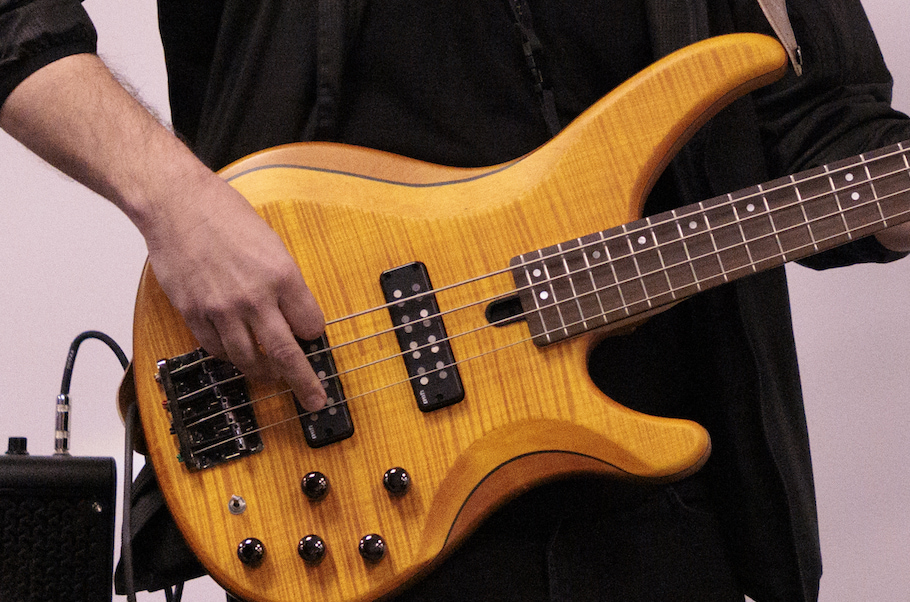A Guide to Bass Pickups
They play a big role in the kinds of sounds you can create.
Music historians may disagree about whether the electric bass was first invented in the early 1920s, the early 1950s or somewhere in-between. But there’s no question that the technological catalyst required to make the concept a reality — a pickup installed to enable amplification of the bass — was a game-changer.
As my old friend and former bandmate/colleague Mac Randall has written about here on the Yamaha blog, guitars first started using pickups back in the 1930s, helping them project from the bandstand. But it wasn’t until the early 1950s that essentially the same invention helped the poor double bassist to be heard.
What Is a Pickup?
Basically, a pickup is a transducer — a device that converts a signal of one type of energy into one of another type of energy; a good example is a microphone, which converts physical sound waves traveling through air into an electrical signal. The earliest electric bass pickups were magnets wrapped a few thousand times in very fine copper wire. The magnetic field around these windings would react to the vibrations of a moving bass string, creating an electrical voltage that could be amplified.
Pickup design and construction have steadily improved since those early days (although some vintage pickups are highly sought after today and often serve as the inspiration for modern designs), giving us lots of great options to choose from. Today, there are a number of different types of pickups — magnetic, piezo and optical — and several intriguing pickup configurations, each with its own subtle but unique set of qualities and characteristics:
– Magnetic pickups are where it all began, with magnets wrapped in copper wire, and are still the most common type of electric bass (and electric guitar) pickup. They include single coil, split coil, double coil (aka humbuckers) and other minor variations on each theme.
– Piezo pickups react to pressure, rather than a change in a magnetic field.
– Optical pickups rely on light that’s shined onto a vibrating string — and the conversion of the resulting shadow caused by those vibrations — to create an amplifiable signal.
Let’s take a closer look at each type, and their common configurations.
Single Coils
A single coil pickup, as its name suggests, is a solitary straight copper wire wrapped around magnetic pole pieces aligned beneath the strings of your bass. Bright and aggressive-sounding, you’ll typically find single coils installed close to the bridge, but you’ll rarely encounter a bass with only one single coil pickup. More usually, you’ll find them coupled with another single coil pickup in the neck or middle position (as in the Yamaha BBNE2 Nathan East Signature Model), or paired with a split coil (see below) in the neck or middle position — the configuration used in all Yamaha BB and RBX Series basses, as well as Yamaha TRBX 200/170 Series basses.

Split Coils
A split coil is pretty much what it sounds like: a single coil split into two parts, each with its own smaller coil. Instead of running straight across the full width of your strings, those two individual coils are staggered, resulting in a signal that’s attractively out-of-phase, which in this case is a good thing. Compared sonically to the single coil, the split coil sounds juicier, with bouncier lows and punchier mids. Some of that comes from the traditional placement of split coils — roughly midway between the end of the fretboard and the bridge (as in the Yamaha TRBX204 shown below), where the string vibrations are more active and harmonic. There are also basses that have two split coil pickups, with the second one installed closer to the bridge.

Humbuckers
One benefit of split coil pickups is that they naturally cancel out electrical hum from lightbulbs and amplifiers that single coils can transmit. As its name suggests, so does the humbucker, also known as a “double coil” pickup. It consists of two single coil pickups connected out of phase with one another, and with their magnets aligned as polar opposites. This effectively cancels out interference, with a side benefit of a hotter signal, making it a popular choice among bassists.
Their sound can vary quite a bit, too. For example, if you like a crisp, modern sound, you’ll love the humbuckers in Yamaha TRBX 300/500/600 Series basses, as well as those in the Yamaha TRBJP2 John Patitucci Signature Bass. But they can also provide a beefier vibe, as in the vintage “mudbucker” inspiration behind the DiMarzio Woofer Pickup found in the middle position of the new Billy Sheehan-designed Yamaha Attitude 30th Anniversary bass.

Piezo
Unlike magnetic pickups that rely on magnetism to convert string vibrations into sound, a piezo-electric pickup uses a thin, compressed layer of crystal installed inside the bridge (under the string saddles) to convert the pressure changes caused by string vibrations into an electrical signal. Piezo pickups aren’t exclusive to acoustic-electric guitars, but that’s where you usually see them. (They’re rarely found on basses.) On their own — that is, without EQ and/or unblended with another pickup — piezos can sound a bit thin, but they faithfully reproduce the unique airiness and zing that define acoustic string instruments. They also have the added benefit of under-bridge installation for a stealth look.
Optical
Optical pickups are an even more esoteric innovation in that they use light to convert string vibrations into an electrical signal. Similar to piezos in their stealth approach, the under-saddle pickup shines a light onto the string and converts the resulting shadow (which changes when the string vibrates) into an electrical signal. Optical pickups aren’t found on many basses just yet, but maybe one day they will be. They’re touted for delivering a noiseless signal with extended frequency range and flat response. And interestingly, they boast longer sustain than magnetic pickups because there’s no magnetic field exerting pressure on the string. This is definitely technology worth keeping an eye on.
It’s All About Taste … As Well As Being Heard
What type of pickup (or pickups) your bass uses makes a big difference in the kinds of sounds you can create. Some players prefer one type — two single coils, for instance — while others prefer to combine types together, such as a middle position split coil paired with a single coil in the bridge position.
Whether you like your pickups underwound or overwound, blended or soloed, made with a specific type of Alnico material or with oversized pole pieces from rare earth materials is up to you. But whether you choose to obsess over it or ignore it, just be thankful there are so many options available. The electric bass pickup of today is a far cry from many decades ago. Bassists back then didn’t argue over how many pickup windings made for the best signal. To them, being heard at all was an improvement!
Check out Michael’s other blog posts.
Click here for more information about Yamaha basses.















